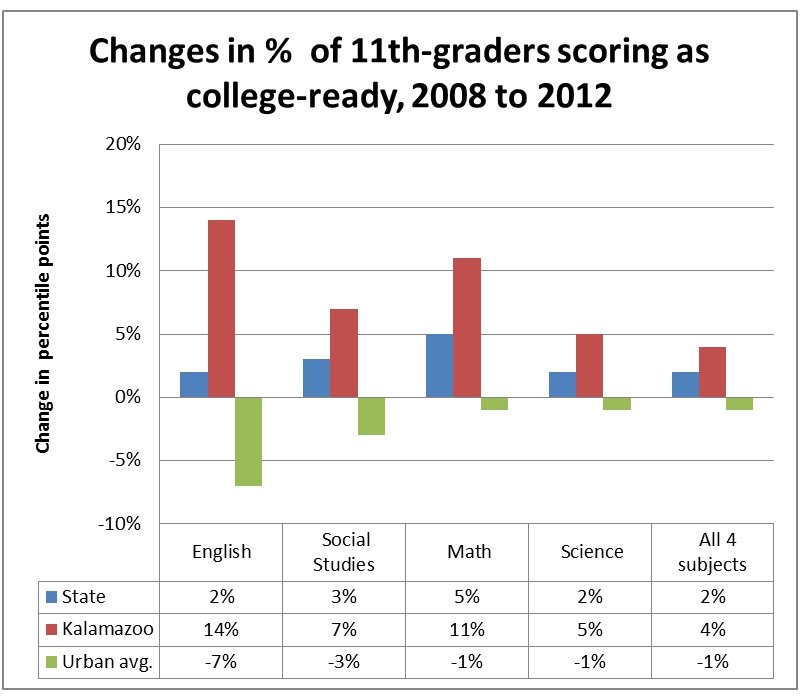The Kalamazoo Promise

The city of Kalamazoo, Michigan is the sixteenth most populous in the state, with just under 75,000 people per the 2010 census. Like many Michigan municipalities, Kalamazoo has been shrinking, population-wise, over the last few decades; in 1990, it was home to over 80,000 people. (Detroit, the largest city in the state, was at 1.027 million people in the 1990 census; per the 2010 census, Detroit’s population is now just under 720,000.) In 2000, 24.3% of Kalamazoo’s population was below the poverty line, including 26% — more than one out of four — of those age 18 and under.
To help fix this, at the November 10, 2005 Kalamazoo Board of Education meeting, the board members announced something dramatic: free or drastically reduced college tuition to many of the city’s school children.
Called the “Kalamazoo Promise,” the program promises to pay the tuition — including mandatory fees (but not room and board) — to any of Michigan’s state colleges, for anyone who attends the Kalamazoo public school system for at least four years and graduates. Anyone who entered the school system in 9th grade receives 65% of their college tuition from the Promise, and for every additional year one spends in the system, that person receives an additional 5%. A child who goes to Kalamazoo’s school system from kindergarten through 12th grade, therefore, is eligible for 100% of their college tuition via the Promise. The Promise is backed by a group of anonymous donors, believed primarily to be comprised of members of the Stryker (of the Stryker Corporation) and Upjohn (of the Upjohn Company) families, and there are rumors that New York Yankee shortstop Derek Jeter (who grew up in Kalamazoo) is also involved.
The goals of the Promise are not just to encourage children to attend college (and to make that possible), but also to encourage families and businesses to relocate to Kalamazoo and keep a flailing city moving forward. (In fact, the New York Times asserted that the Promise is “primarily meant to boost Kalamazoo’s economy.”) As of October 2010, almost five years after the Promise was announced, enrollment in Kalamazoo Public Schools went up 3% from the year prior, bucking the state-wide trend. There are anecdotal reports of the school system improving and the real estate market rebounding; in the latter case, homeowners are regularly advertising their places as “Promise eligible, “Promise qualified,” or the like.
As of 2010, the Promise had paid out $18 million in tuition to roughly 2,000 high school graduates, with no signs of stopping. The effect on students has been mixed, but shows — pardon the pun — promise. As seen in the chart above and discussed by MLive.com (the source of the chart), Kalamazoo is seeing measurable and positive results at the high school level. However, roughly half of those students who received scholarships (through 2011) dropped out before completing their collegiate program. The Promise’s leadership is looking toward ways at better preparing eligible students for college.
Bonus fact: Derek Jeter almost never played for the Yankees — or, at least, he was almost drafted by another team, the Houston Astros. Jeter, fresh out of high school, was selected sixth overall in the 1992 Major League Baseball Draft by the Yankees. The Astros had the first overall pick but passed over him because they were concerned that he’d demand a higher-than-typical signing bonus. (Jeter had earned a baseball scholarship to the University of Michigan and could have used that as leverage.) Hal Newhouser, a Hall of Fame pitcher for the Detroit Tigers from the 1940s, was working for a scout for the Astros at the time and is credited with discovering Jeter. Newhouser forcefully advocated for selecting Jeter, but the Astros failed to take Newhouser’s advice, selecting collegiate star Phil Nevin instead. Newhouser, enraged, quit.
From the Archives: Pennies from Everywhere: One student’s novel way to create a scholarship for himself.
Related: A book titled “I Went to the Party in Kalamazoo.” It’s a children’s book and there’s a drawing of a zoo scene on the cover. There probably shouldn’t be, though; as Wikipedia notes, “[t]here is no longer a zoo in Kalamazoo. The Milham Park Zoo closed in 1974.”
